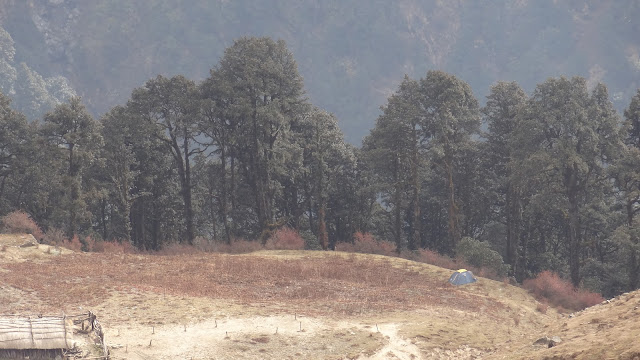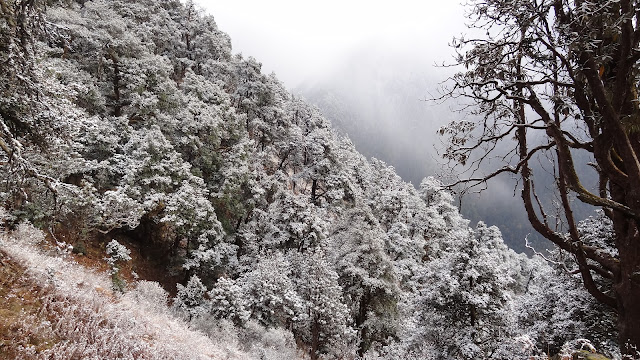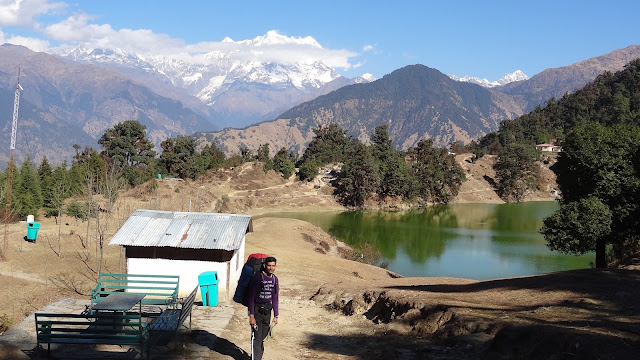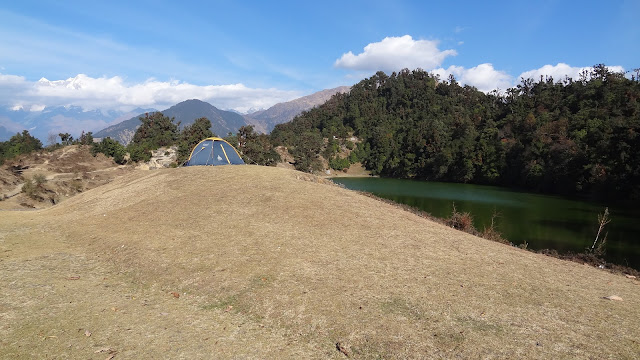Himalayas in My Window - Backpacking in the Hills of Garhwal
Time burnishes memory of cherished
moments.
I met Devi in the summer of 2011.
I saw an young officer being wheeled in the operation theatre daily, for the dressing of his foot. He would wish me, smiling diffidently. Perhaps he is embarrassed to be moved around hospital in a wheelchair, I thought. The procedure did not demand anaesthesia and my presence was not needed. I did not try to learn the cause of his malady.
2011 is etched in my memory as the year
I went on Kailash-Mansarovar trek. Though the trek was only four-week’s long, I
spent months in preparation. I had been smitten by the idea of this Himalayan
journey for a few years. I had no experience of mountain trekking then. I was
looking for seasoned trekkers who could advise me on preparation for the trek.
I contacted our Adventure cell. ‘One of the best climbers of the Air Force is
in your hospital. Take his advice.’
Thus, I learnt that Devi was an accomplished mountaineer. He had sustained frost-bite in his foot while climbing down, after summiting Mount Everest. ‘Foot is bad. I will have to amputate a few toes to save the rest of the limb,’ surgeon told me. Loss of a body-part is devastating. In the fullness of youth and a vigorous life, the mere thought would be like death. I understood Devi’s shy demeanour, a little.
One morning, after his dressing, I invited him to my room in the theatre. I found he was not shy of conversation. Hesitatingly I approached the subject of trekking, ‘will it be fine if I talk of mountains? Please say if you do not want to. I know I am being imprudent.’ He was unfazed. ‘Not at all sir, please do. Mountains are my life.’ I broached the subject of my forthcoming trek and my abject naivety in the sport. Devi spoke of mountains effusively, giving me dollops of information. It was all new to me – and enchanting. He was enthusiastic about my journey. He pooh-poohed my fears, ‘you are marvellously fit. This would be fun every moment of the day.’ He guided me to the adventure cell and made a list of equipment I could borrow from there. He advised me on the exercise schedule for mountain trekking.
I had a roaring time in the trek.
Devi
stayed in the hospital for long. He would often drop by for a cup of tea in my
room. He patiently heard my excited blabber of the Kailash trek. ‘I’ve walked
in the mountains for long stretches, usually on the way to a base-camp. But it
was just a stage in the eventual climb. Never an isolated event. It would be
fun to trek the Himalayas for the mere joy of walking in the wild. Let us
plan a trip. But we would go backpacking, carrying all we need for the trek on
our backs.’ Idea suggested unlimited thrill. But leave alone backpacking, Kailash
was my first mountain trek. Such plans, in the fifth decade of life, boost
self-confidence immensely. I revelled in the suggestion and pushed pragmatic
concerns away.
Devi was posted to a new unit after his recovery. We kept in touch.
‘Are you prepared to go for a trek?’ he rang me
in November, the next year. I had forgotten our plan. Excitement gripped me.
Trekking season in the Himalayas had ended. We frantically searched the web and
few trekking guides we could grab. We settled for Madhyamaheshwar in the
Garhwal Himalayas.
Devi came over to my place a few days
in advance. He had overcome the mental and physical trauma of the past year. He
was excited about the trek. He had a long list of items we would need;
high-altitude tent and sleeping bag, portable stove with fuel canisters, light
utensils, rucksack, trekking mattress, besides food and many knick-knacks. This
was going to be a different game. My apprehensions rose. Throughout my Kailash
trek of about hundred and fifty kilometres, I had a porter to carry my light
rucksack even when it had only a bottle of water, an odd sachet of biscuit, and
the poncho. Rest of the luggage was carried on ponies. A train of these, following
the yatris.
It was November end when we left. Devi
showed me how to pack the rucksack. Sack looked well-endowed and impressive. It
was unyieldingly heavy too. I tottered on my feet as I heaved it on my
shoulders. We jettisoned many items. Devi tightened a strap here and loosened
one there. Bag became manageable. I walked a drunkard’s gait initially, but
soon became steady.
At Haridwar we changed bus for Rudraprayag. I gazed at the captivating landscape in the hazy light of an early dawn. Dusk and dawn in India are fleeting moments. In mountains the transition is more rapid. Soon, the sun was high in the sky. Unending rows of mountains framed the view from the bus window.
Rudraprayag, made famous by the leopard tales of Jim Corbett, lies at
the confluence of Alaknanda and Mandakini rivers, tributaries of Ganga. Like
every holy town in India, it is crowded and untidy. We were happy to jump into
a waiting bus that was leaving for Ukhimath.
Ukhimath town hugs the left bank of
Mandakini. It is a temporary seat of Kedarnath and Madhyamaheswar deities, when
these temples close in winter. Roadhead of the trek was Uniana village, an
hour’s drive off. We caught the last bus.
Chaukhamba, meaning four pillars, a mountain massif in Garhwal Himalayas comprising four peaks, ranging from 22500 ft to 23500 ft, was our constant companion in the trek. I saw its various hues against the changing colour of the sky. I saw it on a moonlit night. I saw its reflection in the still waters of a high-altitude lake. It was breathtakingly beautiful.
Bus dropped us at a derelict joint of a
few shanties. A tea shop, in better shape, had a room to-let. Beyond the room ground fell steeply. A deep wooded valley, hazy in the evening light, lay in the deep. We could hear a feeble
sound of rushing water flowing in the gorge. Chaukhamba in the distance was
turning dark.
We started early the next morning. Morning was cool. Devi had packed all the heavy stuff in his backpack. His bag bulged precariously, still he walked as if strolling on a bazar street.
We met a guide in Ransi village who was returning from Madhyamaheshwar. Our plan was to trek till Kanchani Tal, a Himalayan Lake at 14500 feet, about 16 kms from Madhyamaheshwar. Guide said that the weather was bad up there. ‘Do not think of Kanchani Tal. It’s been snowing there since September. It would be dangerous now. Come back next summer.’ Devi didn’t seem convinced, ‘In mountains, no one can predict the weather. It might improve when we get there.’
Climb on the first day was mild. I
enjoyed trekking with the load slung on my back. It was liberating to know that
we were free to roam these unending hills as we chose. There was no schedule to
follow. We had all we needed for a few days’ ramble on our backs.
After Bantoli village, trail wound
through a thick forest. We had been walking for six hours now. Rucksack had
begun to weigh heavy. Fatigue grew. But the verdant route assuaged the discomfort.
Warmth of dappled sunlight, cool breeze blowing through the jungle, and the
unblemished silence broken only by the soft sounds of falling leaves, were
rejuvenating.
A small clearing in the jungle, with a
dilapidated concrete building and a hut, announced the next village, Khatara. A
man emerged from the hut, as we deposited our rucksacks nearby. On seeing us,
he rushed in again, and came out bearing glasses of water and two lighted
bidis. We politely refused both. We had chlorine tablets to purify the water we
collected from the innumerable streams on the way. ‘Where can we put up our
tent here?’ Fateh Singh was perplexed. ‘But I have beds in my hotel.’ He
pointed towards the shovel. ‘And the building over there’s the guest house.’
Guest house, a small decrepit hall that looked abandoned for years, was dark,
damp, and smelly. Surrounding woods were spartan. But there was no flat ground.
We pitched the tent in the veranda of the guest house.
Devi neatly assembled the tent; first
spreading the full tent on the ground, then threading the flexible poles. I
lent a clumsy hand. As we maneuvered the ends of the poles in the eyelets on
the ground sheet at four corners, tent suddenly popped up. We drove pegs in the
soft earth and secured the tent with guy ropes. Devi unzipped the door. ‘You
enter as if in a low cave.’
We heated some pre-cooked rice for
lunch. Fateh Singh came to inspect our lodgings. He had brought us tea. He was
satisfied with our arrangements, ‘You have a small stove too! Almost everything
you need. Good, but my hotel wouldn’t have been uncomfortable.’
Temperature dipped severely as sun went down. Climbing a small hill, we saw the flickering lights of Uttarkashi town at the end of the long serpentine gorge of Alaknanda. Wisp of smoke was rising from a nearby hut. Yes, they would cook us a meal. Hut was clean. Wife sat at the choolah and baked us hot chapatis. The family came here in summers to earn a living by serving trekkers and pilgrims. ‘You are late sir. Soon the path will close. We will go down in a day or two.’
Straightjacketed in a sleeping bag,
first night was uncomfortable. Mountain was impeccably dark and quiet. It
wasn’t yet seven when we retired. We chatted late into the night. I had
recently read, open mouthed, John Krakauer’s Into Thin Air - a superbly
written account of his disastrous Everest climb in 1996. I didn’t know anything
about climbing then. South Col and North Col, base camp at 17500 ft, the Khumbu
ice falls, leaving the last camp at night to reach the summit early in the
morning, the traffic jam at Hillary step; these were vague but fascinating
names and concepts. I persistently queried Devi. He told me his experience of
various climbs: the stark mountains; the constant fatigue; the
unbearable cold; the heavy climbing gear and the thin mountain air which made
every step a gigantic effort; Everest teeming with climbers, yet no hope of
help if one became sick or suffered injury; bodies of climbers who had perished
during climbs, lying forlornly, preserved immaculately in the perpetual
sub-zero cold.
Soon night grew cold. Warm sleeping bag
now felt cosy, tired muscles began to relax and the constant roar of the river,
flowing deep down the gorge was like a lullaby. I slept without a care.
Next day's climb was short, about nine kms. We got up late, prepared breakfast, packed the tent and left when the sun was high. Path was very steep. Each switchback seemed like the end of the climb, only to reveal an endless trail at its furthest end. We halted every hour to catch our breath. Devi taught me how to balance the backpack on a high rock and lean against it to rest the limbs, without unharnessing. Tall deodar, Cheer pine, and rhododendron grew on the slopes.
An arduous trek of five hours brought
us to our destination of the day. Madhyamaheshwar is a vast meadow, at 11500
ft. It’s surrounded by a ridge in the west and the peaks of the Greater
Himalayas – the Chaukhamba, Kedar, and Neelkanth massifs – in the north. To the
east, ground slopes down into a thickly wooded valley.
A path, paved with rough uneven rocks, led to the temple. A few ramshackle shops bordered the path. We were tired and hungry. Most shops were closed. Owner of a shop that was open cooked us some Maggy noodle, the staple snack and meal in mountains. He told us that most people had packed up for winter. Tomorrow his family would also leave. He agreed to give us dinner too.
The small temple was built of grey stones. Most tourist places in India, from Kashmir to Karnataka, have mythological associations with Pandavas or Ram. Five Kedar temples in Uttarakhand – Kedarnath, Tungnath, Rudranath, Madhyamaheshwar, and Kalpeshwar – represent the places where lord Shiva revealed himself to Pandavas. His navel surfaced in Madhyamaheshwar – hence Madhya (middle) Maheshwar (Shiva). Young priest who was enjoying the last rays of an evening sun narrated this tale, in his heavily accented Hindi. Priests at all Kedar temples are chosen from a Lingayat sect of Karnataka. He pointed towards a peak in the north, the top now shrouded in fog, ‘Between two peaks is Kanchani khal (pass), and beyond that is the tal - the lake. It’s sixteen kms from here. Weather is bad there now. Everyone must leave the meadow by tomorrow. You will require district magistrate’s permission to stay here after that.’
Devi understood that we have to abandon our plan for Kanchani Tal. He was downcast. ‘Oh, it would have been lovely to trek there. We have enough provisions. We could call it off if the weather turned bad, and return here to camp for the night. Imagine, this beautiful valley, all to ourselves.’ We were quite alone even now; not more than 6-8 souls on the large meadow. I wasn’t altogether dissatisfied at abandoning the idea of Kanchani Tal. Mountains in the distance looked intimidating. I couldn’t believe I had it in me to trek to that remote lake. But I kept my own counsel.
We pitched the tent at the edge of the meadow and immediately jumped into our sleeping bags. Through the door of the tent, I could see the snow peaks in between tall trees on the mountain slope. It was a torture to get out and go for dinner. The shop was warm in the fire of the choolah.
Back in the tent I made a cup of coffee. I prodded Devi for more climbing stories. Night was beastly cold. My feet never warmed up even beneath thick woollen socks. I slept desultorily. Coffee soon worked its magic and I had to go out to pee. Moon was high in the sky. Dew lay frozen on the grass. Our tent looked puny and delicate in this magnificent landscape of dark wooded valley and daunting mountains beyond.
At seven in the morning a bright sun was shining on our tent. We lazed a bit in this luxury. Water I had left in the pan the previous night was frozen. Bright, clear sky seemed to belie the weather prediction of the locals; Within an hour, clouds rolled in the sky and snowflakes fell on us.
We zipped the tent and went for a short hike to the ridge top, a distance of two kilometres. View from the top was astonishing. We saw three sixty degrees view of the Himalayas. Clouds were rapidly tumbling down in to the valley from mountain tops. In a few minutes landscape was sheathed in white.
Snow was falling steadily when we descended to the meadow. ‘Dust the snow first, before rolling the tent. It will weigh heavy otherwise.’ Devi advised as we packed the gear. A quick lunch and we began the descent to Khatara. I looked back. The old grey temple, against the white ground, looked fetching. Trees on the mountain, covered in snow, seemed to have broken in a white bloom. On distant mountains, a clear demarcation was visible; woods where snow fell appeared white, and below this line jungle was of a darker shade.
Camping for a night in Khatara, we reached Uniana the next evening and checked in the lodge we had occupied on our way up. We were despondent. Shelving of Kanchani Khal trek had abruptly ended our backpacking. I was happy with the freewheeling itinerary of the last four days.
While searching for a suitable trek last month, I had come across Deoria Tal. Sari village, the roadhead for the trek to the Tal, was a little distance from Ukhimath. Devi thought we could do this. We were upbeat.
In the morning we caught the first of
the two buses, which ply between Uniana and Ukhimath. Bus crawled leisurely,
stopping near every pedestrian on the road, coaxing them to get in. Driver
tooted the horn in front of the houses on the way. Passengers emanated from
their homes and climbed in nonchalantly.
Trek from Sari to Deoria tal was short,
about two kms, but steep. The sight that confronted us as we emerged on the top
was stunning. Instantly I understood how a picture takes your breath away.
Deoria Tal, a small pond, lay like an emerald, embedded in the gently sloping,
lush green ground. It was surrounded by dense forests. In north Himalayan peaks
stood proud. Landscape was uncannily vivid; it didn’t look real. Water of
the pond was clear, and dark in the reflection of the surrounding trees. A
stone-paved foot trail, hemmed it.
We pitched the tent on a small mound next to the pond. While I made tea, Santosh Singh, the forest guard, came to collect the tourist cess. He was here for three years. It was a lonely outpost. He chatted for long. Peaks in the north were Chaukhamba, Kedar dome and Kedar peak, Satopanth, Neelkanth, Shivling, and beyond these the Gangotri glacier. Devi had climbed Satopanth, a peak of 23200 feet. The jungles around had good wildlife. Santosh Singh often sighted leopards, bears, and musk deer. He asked us about the Madhyamaheshwar trek. ‘Did you meet Fateh Singh in Khatara?’ Fateh Singh, he said, was an opium addict. He served hashish and opium in his hotel. We remembered the bidis he had benevolently offered.
We strolled around the pond and the edges of the wood. Himalayan massifs changed colour with the light of the day. In the evening they glowed golden yellow for a short while, before disappearing in the dark. We sat on a bench and silently gaped at this magnificent spectacle. Sun sucked in all light from the landscape as it went down behind the furthest peak. Night fell instantly.
Inside tent it was pleasantly cold. When
I came out later, I saw a night of indescribable beauty. All was bathed in the
soft light of the moon. Himalayan peaks stood out clearly against the
star-studded sky – as if gilded in silver. Their shadow in the still water of
Deoria Tal was as real as the peaks in the distance. Night felt magical.
We were woken by the warmth of the sun seeping into our tents. Devi unzipped the door flap of the tent. Himalayas were framed in my window.
‘Let’s stay here for another day,' we gushed, almost in unison. We went for a hike in the jungle. We lay in our warm tent after lunch. We rambled around the lake in the failing light of the evening. Santosh Singh was not seen. Solitude, on this unearthly spot, seemed complete. Night was ineffably tranquil. Next day we descended to the plains.
We experience the world every waking moment of our lives. Not all these myriad experiences go into our memory; only a tiny fraction does. They form the past we remember. We do not see our lives as a continuum of ceaseless experiences. We see it as a story. The narrative of this story is woven by our memories. It is this narrative which gives meaning to our lives.
Daniel Kahneman, a psychologist and a Nobel laureate, postulated
the Peak-End rule to explain how we judge an experience; We figure how we felt
at the peaks - the most intense moments, and at the end. We do not evaluate the
sum or the average of every moment of the experience. Only the peaks and the
end count.
Madhyamaheshwar trek abounded in peaks
of joys. The end, Deoria Tal, was not of this world. Memory of this journey
glows brighter with each passing day.





















Sir, you have honed your writing skills to perfection. Amazingly well written account of our first trek together. In fact there were so many facets of this expedition that I myself had forgotten and my memory got refreshed after reading this article. Can't wait to go through the account of our next trek and to hit the mountain trail with you once again.
ReplyDelete